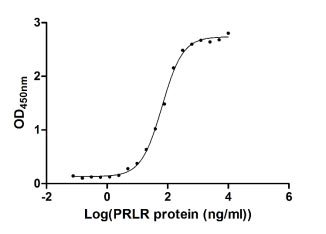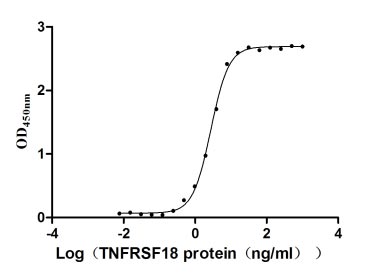Recombinant Rat Ubiquitin carboxyl-terminal hydrolase BAP1 (Bap1)
-
中文名称:Recombinant Rat Ubiquitin carboxyl-terminal hydrolase BAP1(Bap1),Yeast
-
货号:CSB-YP002556RA
-
规格:
-
来源:Yeast
-
其他:
-
中文名称:Recombinant Rat Ubiquitin carboxyl-terminal hydrolase BAP1(Bap1),Yeast
-
货号:CSB-EP002556RA
-
规格:
-
来源:E.coli
-
其他:
-
中文名称:Recombinant Rat Ubiquitin carboxyl-terminal hydrolase BAP1(Bap1),Yeast
-
货号:CSB-EP002556RA-B
-
规格:
-
来源:E.coli
-
共轭:Avi-tag Biotinylated
E. coli biotin ligase (BirA) is highly specific in covalently attaching biotin to the 15 amino acid AviTag peptide. This recombinant protein was biotinylated in vivo by AviTag-BirA technology, which method is BriA catalyzes amide linkage between the biotin and the specific lysine of the AviTag.
-
其他:
-
中文名称:Recombinant Rat Ubiquitin carboxyl-terminal hydrolase BAP1(Bap1),Yeast
-
货号:CSB-BP002556RA
-
规格:
-
来源:Baculovirus
-
其他:
-
中文名称:Recombinant Rat Ubiquitin carboxyl-terminal hydrolase BAP1(Bap1),Yeast
-
货号:CSB-MP002556RA
-
规格:
-
来源:Mammalian cell
-
其他:
产品详情
-
纯度:>85% (SDS-PAGE)
-
基因名:
-
Uniprot No.:
-
别名:Bap1Ubiquitin carboxyl-terminal hydrolase BAP1; EC 3.4.19.12; BRCA1-associated protein 1
-
种属:Rattus norvegicus (Rat)
-
蛋白长度:Full length protein
-
表达区域:1-727
-
氨基酸序列MNKGWLELES DPGLFTLLVE DFGVKGVQVE EIYDLQSKCQ GPVYGFIFLF KWIEERRSRR KVSTLVDDTS VIDDDIVNSM FFAHQLIPNS CATHALLSVL LNCSNVDLGP TLSRMKDFTK GFSPESKGYA IGNAPELAKA HNSHARPEPR HLPEKQNGLS AVRTMEAFHF VSYVPITGRL FELDGLKVYP IDHGPWGEDE EWTDKARRVI MERIGLATAG EPYHDIRFNL MAVVPDRRVK YEARLHVLKG NRQTVLEALQ QLIRVTQPEL IQTHKSQESQ LPEESKPASS KSPFGLEAGR TPAASECTHT DGAEEVAGSC PQTTTHSPPS KSKLVVKPSG SSLNGVPPTP TPIVQRLPAF LDNHNYAKSP MQEEEDLAAG VGRSRVPVRP QQYSDDEEDY EDEEEDVQNT SSAIRYKRKG TGKPGSLSNS SDGQLSVLQP NTINVLTEKL QESQKDLSIP LSIKTSSGAG SPAVAVPTHS QPSPTPSNES TDTASEIGSA FNSPLRSPIR SANPTRPSSP VTSHISKVLF GEDDSLLRVD CIRYNRAVRD LGPVISTGLL HLAEDGVLSP LALTEGGKGS SPSTRSSQGS QGSSSLEEKE VVEVTDSRDK SGLNRSSEPL SGEKYSPKEL LALLKCVEAE IANYEACLKE EVEKRKKFKI DDQRRTHNYD EFICTFISML AQEGMLANLV EQNISVRRRQ GVSIGRLHKQ RKPDRRKRSR PYKAKRQ
-
蛋白标签:Tag type will be determined during the manufacturing process.
The tag type will be determined during production process. If you have specified tag type, please tell us and we will develop the specified tag preferentially. -
产品提供形式:Lyophilized powder
Note: We will preferentially ship the format that we have in stock, however, if you have any special requirement for the format, please remark your requirement when placing the order, we will prepare according to your demand. -
复溶:We recommend that this vial be briefly centrifuged prior to opening to bring the contents to the bottom. Please reconstitute protein in deionized sterile water to a concentration of 0.1-1.0 mg/mL.We recommend to add 5-50% of glycerol (final concentration) and aliquot for long-term storage at -20℃/-80℃. Our default final concentration of glycerol is 50%. Customers could use it as reference.
-
储存条件:Store at -20°C/-80°C upon receipt, aliquoting is necessary for mutiple use. Avoid repeated freeze-thaw cycles.
-
保质期:The shelf life is related to many factors, storage state, buffer ingredients, storage temperature and the stability of the protein itself.
Generally, the shelf life of liquid form is 6 months at -20°C/-80°C. The shelf life of lyophilized form is 12 months at -20°C/-80°C. -
货期:Delivery time may differ from different purchasing way or location, please kindly consult your local distributors for specific delivery time.Note: All of our proteins are default shipped with normal blue ice packs, if you request to ship with dry ice, please communicate with us in advance and extra fees will be charged.
-
注意事项:Repeated freezing and thawing is not recommended. Store working aliquots at 4°C for up to one week.
-
Datasheet :Please contact us to get it.
靶点详情
-
功能:Deubiquitinating enzyme that plays a key role in chromatin by mediating deubiquitination of histone H2A and HCFC1. Catalytic component of the PR-DUB complex, a complex that specifically mediates deubiquitination of histone H2A monoubiquitinated at 'Lys-119' (H2AK119ub1). Does not deubiquitinate monoubiquitinated histone H2B. Acts as a regulator of cell growth by mediating deubiquitination of HCFC1 N-terminal and C-terminal chains, with some specificity toward 'Lys-48'-linked polyubiquitin chains compared to 'Lys-63'-linked polyubiquitin chains. Deubiquitination of HCFC1 does not lead to increase stability of HCFC1. Interferes with the BRCA1 and BARD1 heterodimer activity by inhibiting their ability to mediate ubiquitination and autoubiquitination. It however does not mediate deubiquitination of BRCA1 and BARD1. Able to mediate autodeubiquitination via intramolecular interactions to couteract monoubiquitination at the nuclear localization signal (NLS), thereby protecting it from cytoplasmic sequestration. Acts as a tumor suppressor.
-
亚细胞定位:Cytoplasm. Nucleus.
-
蛋白家族:Peptidase C12 family, BAP1 subfamily
-
数据库链接:
KEGG: rno:306257
STRING: 10116.ENSRNOP00000025853
UniGene: Rn.3382
Most popular with customers
-
Recombinant Human Somatotropin (GH1) (Active)
Express system: Mammalian cell
Species: Homo sapiens (Human)
-
Recombinant Macaca fascicularis Angiotensin-converting enzyme (ACE2), partial (Active)
Express system: Mammalian cell
Species: Macaca fascicularis (Crab-eating macaque) (Cynomolgus monkey)
-
Recombinant Human Tumor necrosis factor receptor superfamily member 18 (TNFRSF18), partial (Active)
Express system: Mammalian cell
Species: Homo sapiens (Human)
-
Recombinant Human Claudin-18.2 (CLDN18.2)-VLPs (Active)
Express system: Mammalian cell
Species: Homo sapiens (Human)
-
Recombinant Rabbit Tissue factor pathway inhibitor (TFPI) (Active)
Express system: Mammalian cell
Species: Oryctolagus cuniculus (Rabbit)
-
Recombinant Human C5a anaphylatoxin chemotactic receptor 1 (C5AR1)-VLPs (Active)
Express system: Mammalian cell
Species: Homo sapiens (Human)
-
Recombinant Human Epithelial discoidin domain-containing receptor 1 (DDR1), partial (Active)
Express system: Mammalian cell
Species: Homo sapiens (Human)
-
Recombinant Human Cytotoxic and regulatory T-cell molecule (CRTAM), partial (Active)
Express system: Mammalian cell
Species: Homo sapiens (Human)





-AC1.jpg)














